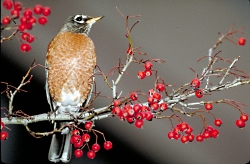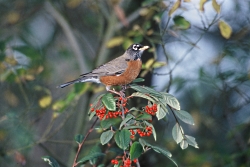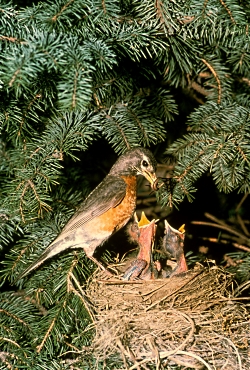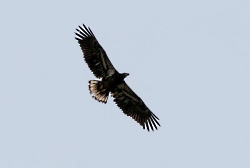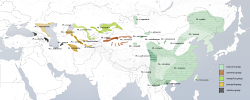
Common Pheasant in Eurasia
Courtesy Wikimedia
Licensed Under CCL Attribution Share-Alike 3.0 Ported
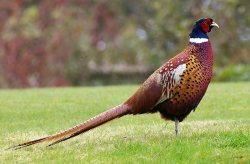 Male Ring-Necked Pheasant
Male Ring-Necked PheasantCourtesy Wikimedia
Gary Noon, Photographer
Licensed Under CCL Attribution Share-Alike 2.0 Ported
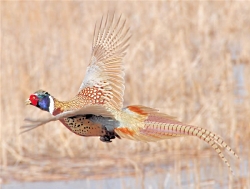 Male Ring-Necked Pheasant in flight
Male Ring-Necked Pheasant in flightCourtesy US FWS & Wikimedia
Magnus Manske, Photographer
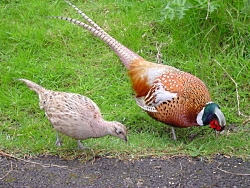 Male(R) and Female(F)
Male(R) and Female(F)Ring Necked Pheasant
Courtesy Wikimedia, Chris O, Photographer
Licensed Under CCL Attribution Share-Alike 3.0 Ported
Hi I’m Holly Strand from the Quinney College of Natural Resources at Utah State University.
It’s spring, and the birds are starting to make quite a racket outside. Here’s a bird we hear every day now, in the morning or at dusk: [https://www.xeno-canto.org/explore?query=common+pheasant]
That’s the sound of a male ring-necked pheasant crowing and then beating his wings against his body. The male is announcing his territory which may be 7 acres or more. Under the right conditions his announcement can carry up to a mile. Looking out the window, I often see our resident pheasant marching around the yard, sometimes herding a female or two, or three. For the dominant males keep female harems during the mating season.
Last year another male wandered up our driveway. This led to a skirmish. The two males held their heads low, rumps raised and tails straight out behind. They pecked and said some choice words to each other in pheasant language. Periodically they burst into a fluttering fight that involved some vicious biting, and kicking. Eventually the intruder left leaving the other to resume his post as head pheasant of our yard.
If you haven’t ever seen a ring-necked pheasant you are in for a treat when you do. The males have a green iridescent head, a bright red face, and a distinctive white ring collar. Their spectacular multicolored plumage ends in a long coppery tail cropped with thin black bars. The females are much smaller; their feathers a mottled mixture of brown and buff with dark markings. While not so beautiful, they are much harder to see and therefore are safer from predators.
All pheasants are natives of the Old World–more specifically of southern Asia. The ring-necked pheasant is not a distinct species there. It’s an informal name that refers to certain subspecies of the Common Pheasant, which occupies a huge territory stretching from the Black Sea and Caucasus region through Central and Middle Asia all the way through China Korea and the Russian Far East. Throughout this enormous territory, over 34 different subspecies of common pheasant have evolved– some with a ringed marking around their necks and some without. What we have here in America is a hybrid mix of a few of these ring-necked subspecies—mostly from China.
Because of their huge popularity as a game bird, ring-necked pheasants have been transplanted all over the world. In the U.S. the pheasant was introduced on the west coast in the 1860’s , but now you can find them in all but the most southern states. They are especially concentrated in our central Corn Belt region.
The ring-necked pheasant was first introduced to Utah around 1890. Their numbers are maintained through transplanting, natural dispersion and further releases of game-farmed birds. Some of those birds end up on the dinner table and some of them find refuge on private lands and in Utah neighborhoods like ours.
Thanks to Paul Marvin for his Xeno-Canto recording.
For sources, pictures and more information, go to www.wildaboututah.org.
For Wild About Utah, I’m Holly Strand.
Credits:
Images:
- Native distribution the Common Pheasant in Eurasia
https://commons.wikimedia.org/wiki/File:Phasianus_colchicus_distribution.png - Male Ring-Necked Pheasant https://commons.wikimedia.org/wiki/File:Pheasant.jpg
- Male Ring-Necked Pheasant in flight https://commons.wikimedia.org/wiki/File:Ringnecked_pheasant_flying_USFWS.jpg
- Male and female Ring-Necked Pheasant https://commons.wikimedia.org/wiki/File:Male_and_female_pheasant.jpg licensed under Creative Commons Attribution 3.0 License.
Text: Holly Strand
Sources & Additional Reading
Giudice, John H. and John T. Ratti. 2001. Ring-necked Pheasant (Phasianus colchicus), The Birds of North America Online (A. Poole, Ed.). Ithaca: Cornell Lab of Ornithology; Retrieved from the Birds of North America Online: https://bna.birds.cornell.edu/bna/species/572
Heinz, Gary H. and Leslie W. Gysel. 1970. Vocalization Behavior Of The Ring-Necked Pheasant. The Auk, 87: 279-295. https://sora.unm.edu/sites/default/files/journals/auk/v087n02/p0279-p0295.pdf
Johnsgard, P. A. 1999. The pheasants of the world. 2nd ed. Smithson. Inst. Press, Washington, D.C.
All About Birds: Ring-Necked Pheasant https://www.allaboutbirds.org/guide/ring-necked_pheasant/id
Audio:
Paul Marvin, XC163168. Accessible at www.xeno-canto.org/163168. License: Creative Commons Attribution-NonCommercial-ShareAlike 3.0
Date 2011-06-04
Location National Bison Range, Dixon, Montana


